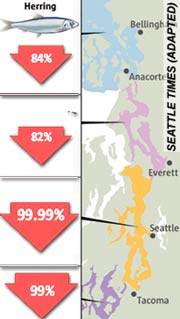
Gov’t Experts: Hordes of jellyfish 10 blocks long off west coast of Seattle; So dense it’s like you can just walk on them… Disturbing when all you pull up are huge masses of jellyfish — NPR: They seem to be replacing fish in food chain — Herring disappear, mysterious spike in salmon deaths (PHOTOS)
ENE News
.jpg) the little fish that salmon, and even orcas, depend on. Mostly they get big hauls of jellyfish. Greene recalls one of the biggest — (Green): “The net was so filled with jellyfish we couldn’t bring it on board. It was too heavy for our winch. It’s fairly disturbing when all you pull up are these huge masses of jellyfish.”… Jellies seem to be replacing the tastier parts of the food chain, like herring… federal biologists can’t explain why forage fish, like herring, have declined by 98 percent or more in much of Puget Sound.
the little fish that salmon, and even orcas, depend on. Mostly they get big hauls of jellyfish. Greene recalls one of the biggest — (Green): “The net was so filled with jellyfish we couldn’t bring it on board. It was too heavy for our winch. It’s fairly disturbing when all you pull up are these huge masses of jellyfish.”… Jellies seem to be replacing the tastier parts of the food chain, like herring… federal biologists can’t explain why forage fish, like herring, have declined by 98 percent or more in much of Puget Sound.
Christopher Krembs, Washington Dept of Ecology oceanographer: “Fall and winter, the patches were just enormous… not just a few blocks long; some of them were 10 blocks long… it was so dense, you had the feeling you could just walk on them.”
Seattle Times, May 2, 2015: Prime fish give way to hordes of jellyfish in Puget Sound… Over the past 40 years, the researchers found that the numbers of herring and smelt have plummeted… herring catches were 1 percent or less of what they were… [P]ollution can impair reproduction in forage fish… But even in the relatively undeveloped Rosario and San Juan basins to the north, herring catches have fallen by more than 80 percent… “People who have a history of being out on the water will say: ‘There sure are a lot more jellyfish than there used to be,’” [Univ. of Washington fisheries professor Tim Essington] said… In recent years, [Krembs] noticed larger and more frequent blooms… a huge bloom of moon jellies [was seen] in October — when jellyfish usually start a seasonal decline.
NOAA, May 2015: Pacific herring and surf smelt… declined by as much as two orders of magnitude… with jellyfish-dominated catches jumping three to nine-fold in the same sub-basins… In some cases more than nine of every 10 tows of trawl survey nets in recent years brought in catches dominated by jellyfish… The research may also help resolve the mystery of why juvenile salmon survival has declined sharply in Puget Sound… “there is clearly a compelling pattern of change in Puget Sound food webs that may be linked to human influence,” said Casey Rice, a [NOAA] research fish biologist.
KUOW broadcast here | More photos here
Published: May 14th, 2015 at 3:13 pm ETBy ENENews |
